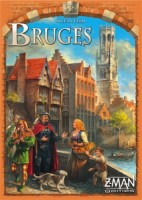
Bruges
Overview
In Bruges, players must balance their resources in order to win over the influence of prominent persons of the 15th century Belgian city of Bruges. Players use cards and their money or guilders to build houses, recruit citizens, fend off threats such as floods and plagues, and recruit workers. Players seek also to gain reputation as they work to complete one of two fabulous canals that encircle the city. When one of two decks of cards runs out, the game ends and the player who has collected the most victory points from various assets wins the game.
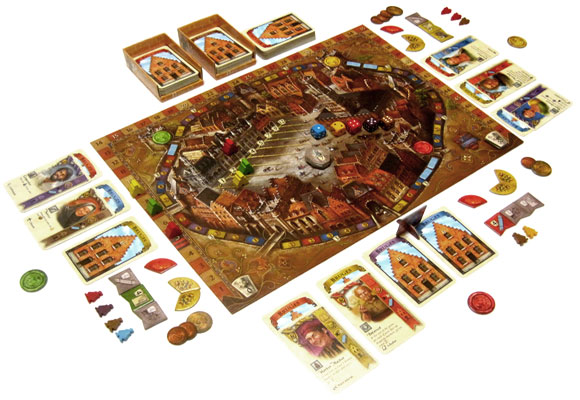
Set Up
Note: There are five key colors in the game of Bruges: red, purple, brown, yellow and blue. These colors appear throughout the game and are all tied together. They are integral to most components and game play.
The board is laid out and players choose a Seal in their player color and place in on one of the 4 Guard House spaces at the perimeter of the city. Each player also has 2 player pawns in their player color. One is placed in the center of the board on the Town Hall and the other is placed on the number 5 on the score track. Each player is also given 3 Majority markers in their color, 5 Guilders and one worker in each of the 5 key colors.
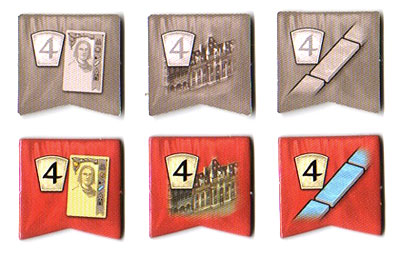
There are 165 cards in the game and their set up is quite unique. Each card is two sided: the front is an image of a house in one of the 5 key colors, and the other side has actions icons along the right hand side as well as the image of a Person and their game effects. These 165 cards are shuffled then divided into 5 equal piles with the “Person” side down. One pile is chosen for each player participating in the game. (2 piles for a 2-player game and so on) These stacks are then shuffled together. The other cards are set aside. The newly formed stack is then divided into two equal draw decks and placed in the nifty cardholders that come with the game. Finally, the first player token and the 5 dice (also in the 5 key colors) are given to the first player.
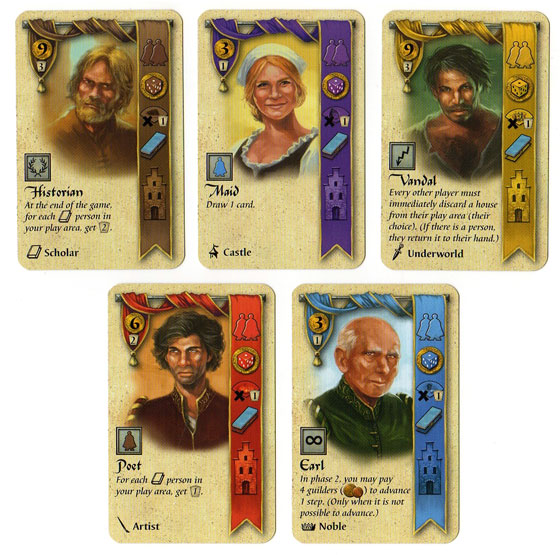
Gameplay
There are four phases in the game of Bruges and all players must complete each phase in order before the next phase begins.
Phase 1: Draw cards
In phase 1, players draw up to their maximum hand size which is usually 5 cards. Since there are two draw piles, and the color of the cards is visible, each player may choose which of the two decks to draw from but may not look at their cards until their hand is refilled. Cards drawn during Phase 1 will be used during Phase 3.
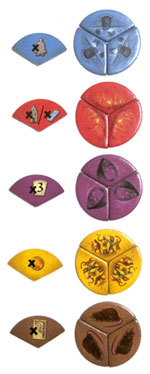
Phase 2: Roll the Dice
The first player rolls the five dice and they are placed on the board in their respective spaces – lowest to highest. The results of the dice are then resolved: For every die that shows a 5 or a 6, a Threat marker matching the color of that die is given to each player. In this way, threat markers accumulate from turn to turn. Once a player has 3 of any single color Threat, that player will suffer a penalty corresponding to the color of the Threat. Suffer a “flood” (Blue) and it washes away all your workers, suffer a “raid” (Yellow) and all your guilders are stolen and so forth. Next, the sum of all the dice that show a 1 and 2, are totaled and this sum is the cost in Guilders to advance one step on the Reputation track. Players may choose to pay that cost and move their player marker one step higher on the Reputation track. Results of a 3 and a 4 have no effect in Phase 2.
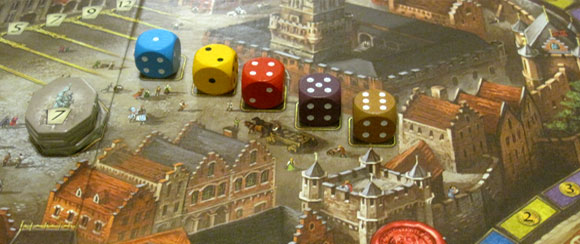
Phase 3: Play cards and perform actions
Every card in Bruges has 3 possible uses. Resulting in 6 possible actions a player may take. Each player in turn chooses and plays one card from their hand and takes one of the 6 actions:
- Build a House: Players pay one worker matching the color of the card and place the card house side up in front of them.
- Collect 2 Workers: Take 2 workers of the color matching the card played. The card is discarded.
- Take Guilders: The player collects a number of Guilders equal to the colored dice matching the color of the card played. The card is discarded.
- Discard a Threat Marker: The player discards a Threat marker matching the color of the card played. The card is discarded.
- Build a Canal token: The player may pay the cost of the next available space adjacent to their Guard House and place a Canal token there. The card played must match the color of the Canal space to be built. The card is discarded.
- Recruit a Person: The player may play the card face up in front of them onto one of their empty houses. The game play effect on the Person card may now be activated when applicable. Players may activate one or more of their Persons’ effects during their turn. This is a key aspect of game play as this enhances the players’ ability to perform actions and affect their advancement toward victory. Each has a specific activation requirement and game effect.
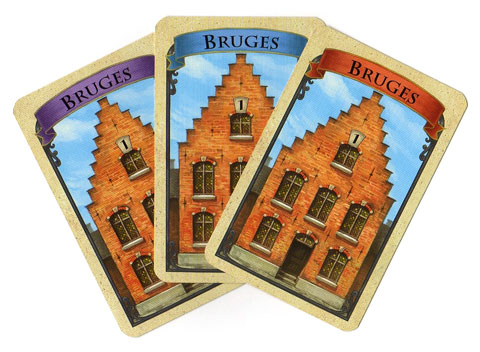
Players play cards and take actions exactly 4 times, which will usually leave one unused card in their hand. At this point Phase 3 ends.
Phase 4: Verify Majorities and Change Start Player
Players have 3 majority markers in their player color that begin face down. During phase 3 they check to see if they have the most canals built, the most Reputation or the most People in play. If so, they flip the corresponding marker face up (scoring 4 VP at the end of the game.) The Start Player banner is then passed to the next player in clockwise order.
The game continues until one of the 2 draw decks runs out. At this point, the left over cards that were set aside are placed in the empty cardholder and the rest of the round is completed. The game then ends and scores are tallied.
Players score points for each house they built, for their level of Reputation, for completed Canals, for their face up Majority markers and the People they have in play. Points are also scored from the end game effects on some of their Person cards. After all points are tallied and marked on the scoring track the player with the most Victory points has won!
Components
Michael Menzel has created a delicacy for the eyes. The art and component design are elegant and seamless. Person illustrations are very well done and show emotion and intent. From the smiling Maid, and the intense Storyteller to the sinister Vandal, the characters bring the game to life as they would an actual city. Thick cardboard tokens and sturdy wooden Belgeeples? are a staple for Z-man games. But the inclusion of two card trays is inspired. They make set up and game play much more enjoyable.
Learning Curve
Very easy to learn and get playing as the game’s strategy and depth emerge as game play evolves.
Who would enjoy this game?
Final Thoughts
Bruges has all the attributes that would classify it as a Euro game: resource management, a Victory point track with multiple paths to gain them, little wooden “Belgeeples” and some may say a loose theme of gaining reputation and prestige in a pre-19th century European city most Americans have never heard of. Getting drowsy?
Not so fast! Bruges offers some things that many historical Euros do not: a strong theme through the personalities in the game.
It seems Stefan Feld was inspired by Aristotle who said: “Plot is character, revealed by action.” Rather than faceless wooden workers, there over 160 characters that breathe life into the city (and the game). Each Person in the game has unique art, belongs to a certain class of citizenry, (Nobles, Clergy, Scholars and so forth) and many have unique game effects that fit their titles. In fact, there are no completely duplicated Persons in the game. And if these mechanics round out the game play with strategic choices, this is secondary to the personality they provide to the experience. In fact, it’s interesting that the game calls them “Persons” as opposed to characters or people. They truly give the game its “person-ality.” How?
The multiple uses for the single game component (the Person cards) is the core mechanic that elevates the experience. Players can only play 4 cards per turn, and choosing whether to use each card to recruit that Person (giving that player VP and longer lasting game play effects), or abandon the Person’s game play effects for resources or to build a house requires planning, sacrifice and some luck of the draw. This luck is creatively mitigated by having each card’s color visible on the card back a well as having the draw deck divided into two separate piles. So, before you draw you can craft a strategy based on one of the five key colors. However, when you are finally able to see the card you drew, you may now have a Person in hand that you may “need.” The card may grant a lot of VP, or be of a class that keys off of another Persons’ game effects in front of you. In this way, something remarkable happens: like true history or intriguing novels and despite your best intentions, you may find that the personalities propel your game off in unexpected directions. If the action comes from the personalities, the conflict comes from… the dice.
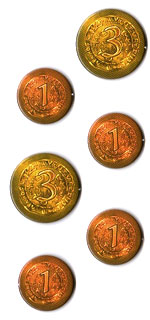
Dice mechanics in Euro games have been more common of late, however the use of the five dice in Bruges, keyed to the five key colors of the game, provide unique possibilities each turn. These possibilities are shared and affect all players simultaneously. Every turn, the dice determine the value of your cards in hand as a monetary resource (Guilders), like an instant ancient stock market of old. They determine the cost to advance in Reputation, and then there are the Threats. Fives and sixes give all players a Threat token of that matching color to every player and as a result, Person cards must at some time be allocated to get rid of them or the results can be crushing. Each Threat carries its own consequence: Total loss of workers, guilders, loss of a Person card or a house or Canal token. This mechanic gives the game an underlying tension; almost like the outside unpredictable influences that shape history.
As with many Euros, there is a visible Victory Point Track, which may demoralize players in last place, and the game is not very confrontational – although there are less reputable persons in the town that can “mess with” other players. But these are slight detractions. Best yet, with all the choices and innovations, the game remains exceedingly simple to learn and play. For this reason, it’s a great ‘gateway game” for those interested in euro games. It’s a wonderful work of craftsmanship that belies expectations and even perhaps “euro prejudice.” Sometimes, great games, like great stories, just have everything fall into place. So it is with Bruges. Count it among the very best of what board games ought to be.
User Reviews (10)
Add a Review for "Bruges"
You must be logged in to add a review.


I made the decision to purchase Bruges based solely on this website’s review and picture of the game set-up (the two user reviews that precede mine weren’t available at that point). Being a toddler in the board gaming world, I knew Stefan Feld’s games were favorites among Euro lovers but I’d never played one. I did, however, know that I loved Lords of Waterdeep, and from what I’d read Bruges sounded like a logical “next step”. I’ve played it obsessively for the last 6 weeks, and these are my impressions:
Observed Set-Up and Play Time
There is a decent amount of first-time preparation involved with Bruges – several sheets of cardboard to punch, two card holders to assemble and an intuitive but imperative rulebook to read line-for-line. I was close to an hour and a half of work before beginning the first game. Repeat plays actually take a surprisingly long time to set up as well, owing to the excellent but time-consuming card mechanic. To prepare for each game you must separate the entire stack of cards into 5 equal decks (33 cards apiece), then shuffle as many of those 33-card decks as there are players in the game together (i.e. 66 cards for a 2-player game, 99 cards for a 3-player game, etc.). You then take this new deck and split it as evenly as possible into 2 decks… so in the 3-player, 99 card example you would have a 45 card deck and a 44 card deck. The remaining cards (in a 3-player game, the other 66 cards) get shuffled together and set aside to serve an end-game function. It’s actually an awesome system… but makes it so that Bruges takes at least 15 minutes to set up for each play. My games have taken about 25 minutes per player.
My Learning Curve and Teach Time
Bruges is a strategy-rich Euro, so you’re nearly always learning. As such, it’s a game where a newbie will have little chance against a vet, and it really doesn’t have a great mechanic for keeping that vet from “running up the score”. As far as simply learning gameplay rules, everything here is so intuitive that 1 game is sufficient to get all of the dos and don’ts down. But teaching can be a little difficult – for a 1-hour game, there’s a lot going on. If you’re a clear and concise teacher, you’ll be able to impart the game onto a first-timer adequately in around 20 minutes. If you’re an occasionally confusing and rambling teacher (as I am) that first-timer may be better off with the rulebook.
Group Sizes and Dynamics
I cannot get certain people in my group to play theme-light Euro games, and Bruges is unsurprisingly an impossible sell to them. While this is, of course, their loss, I feel like they’re being deprived of a memorable experience and never stop pushing it on them (to no avail). I am lucky to have 2 people to play with who cherish a game for its mechanics and overall fun factor, and this has become a favorite for the 3 of us. Make sure those people are in your group, and Bruges will be a huge hit.
Objectionable Material
Unless there’s something I’m just not thinking deeply enough on, Bruges is an objection-free game. But it is no child’s game. Plenty of reading and nothing “cool” about the theme, it will be hard to get a 10-year-old to sit for this one. It could benefit from a Bruges Junior (a la Catan Junior), but lacking that game’s sales figures, this is a pipe-dream.
Comparable Titles
If you’re already a fan of Feld’s games, this will be right in your wheelhouse. I plan on picking up a few titles from his back catalog due to my fondness for Bruges. As I mentioned above, the theme is not far from Lords of Waterdeep… but the gameplay is radically different. This is a great next step from any entry-level Euro – a little more complicated and deep, but not too weighty to require years of board gaming experience before attempting.
Bruges is a study in contrasts; the theme is unlikely to engage most gamers in any meaningful way, but the gameplay itself simply can’t be topped. Your liking or disliking of the game will depend largely on how much you require theme to keep you engaged. I love theme… it sells otherwise mediocre games to me, and gives me some enjoyment out of them. But at the end of a game night, my one and only hope is that I had fun. I have more fun with Bruges than any game save 2 or 3 of my all-time favorites. I can also state that Bruges is my favorite competitive game (the aforementioned “2 or 3” being cooperative) and favorite Euro. If you relish direct conflict in your competitive games, however, Bruges is very light in this regard (a plus for me). There are only 2 or 3 things you can do to affect your opponents directly, and they’re correctly classified as “minor inconveniences”, not “major distractions” (which I’d consider, for instance, mandatory quests in Waterdeep). This may seem like a few large qualifiers, but if you appreciate extremely fun, original game mechanics and “I do my thing, you do yours” competitive games, welcome to Mecca.
After reading some early reviews of Bruges I was fairly sure this would be my first no buy from Feld in a long time. As time went by and I read more and more about it my mind my view about it changed considerably. Bruges is not a very heavy game compared to other recent games by Stefan, in fact since Rum & Pirates it probably only beats out Speicherstadt in that aspect. Still, there is plenty of depth in this game despite a fairly short play time.
Overview :
Bruges has Stefan Feld written all over it. As usual theme is somewhat absent, but with great entangled mechanisms that come together to form a great game and a lot of different ways to score points. In Bruges cards take center stage as you play a card to perform 1 of 6 possible actions which again often is dependent on the colour of the card with each card having 2 sides, a house on one and a person on the other side with a unique effect.
1) Gain 2 workers
2) Money equal to the die value
3) Discard threat
4) Build house by discarding worker
5) Build part of the canal
6) Add a person to 1 house
Every action except 6 is dependent on colour of the card you played.
Each turn is built up by 4 phases:
1) Draw cards up to 5, choosing between two piles.
2) Roll 5 dice, resolve threat, advance reputation
3) Play 4 cards to choose between the above actions (1 player at a time)
4) Earn majorities
In addition a lot of the persons have abilities that may be used during your turn often with the cost of a worker in one specific colour.
Thoughts :
Despite my doubts Bruges proved me wrong and although on the lighter side of the Feld scale it is deep with a high degree of replayability. All in all it might be the most family friendly game by Feld while at the same time having enough meat for seasoned gamers as well. Except for the preparation of cards there is really isn’t a whole lot to setup/prepare before you can start nor between turns. Once again Stefan Feld comes up with an unusual use of dice in his game.
Heartily recommended.
The first and most obvious thing you’ll notice about Bruges is that it was very lovingly crafted. All of the character cards are unique in name and artwork, and though some abilities do repeat themselves across different characters, there is a myriad of possibilities. Though it looks a little confusing at first, Bruges is charmingly simple to play — it’s just a bit deeper than it appears on the surface.
Though the (again, very beautiful and well-made) board seems crowded and complicated, there are very few ways to actually score in the game: influence, canals, houses, character worth, and some character abilities. Every card has some utility, whether it’s for the character’s ability, using it to hold off a fire or flood or other disaster, building a house with it, or just discarding it for guilder (cash), there’s never a dead card in your hand. However, the interplay of abilities and colors mean that you need to draw, choose, and plan very carefully to maximize the impact of your cards. It is a VERY Euro game.
However, that attractive feeling of building your beautiful section of the city is also the game’s central problem. In the game we played this weekend, one of our players played the Loadmaster, which allowed him to gain victory points equal to twice the number of his canals (4). Every turn we helplessly watched him garner 8 VPs for one measly blue worker. Even though I had (and liberally used) the Arsonist and Mountebank, I couldn’t burn down enough houses or plague enough characters to kill the Loadmaster, and he finished far ahead of everyone else. I know that spreading abilities across so many characters is challenging, but with very few options to actually attack other players, a broken character like the Loadmaster can make the game very not fun for those who don’t have an equally broken card.
Also, there’s the Puppeteer. Uggggh. That creepy smile, and that puppet, and that hairstyle….you’ll see.
Bruges is a gorgeous game with a lot of head and heart put into it. It is an excellent game, but losing to a single too-powerful card (and my natural inclination towards American-style games and away from Euros) gave the fun I had playing it a bit of a hit.
Also, the Puppeteer. Just…uggggh.
Concept
The historical town of Bruges in Belgium is the game setting.
Your goal is to earn prestige by :
– Building houses
– Dealing with threats
– Recruiting important persons
– Building canals
– Stepping up on the reputation track
You do this by playing cards (5 different colors), for each card played you choose one of 6 functions (gain workers, gain guilders, deal with a threat, build a canal, build a house or house the person on the card).
The persons on the cards all have a unique ability, which you can use when you recruit them.
Material
The art is top notch, especially the 165 different (!) cards and the board are beautifull and functional.
The setup time is reasonable short.
Rules
The rules may look, at first glance, not that easy for casual/family gamers, but in fact they are not that difficult, the game material helps very well in understanding them. Once played, you don’t need the rulebook for future plays!
Gameplay
You need some luck with the cards, but the many choices of each card give you enough tactical options to build up a strategy. There is some interaction in the game (majorities, some cards), but not much.
I love the pace of the game. The playing time is not very long (and can be variable, depending on your wishes).
I personally think the gameplay reflects the theme very well (I’ve read other opinions).
Negative points
Some game colors can be confusing (yellow/brown and purple/brown), though it’s mostly no problem for me. I think the designer wanted to use colors that fit the medieval town of Bruges (mostly brownish).
And yes, I know the game board is not 100% the real Bruges, but its function is mainly to keep the scores.
Conclusion
If you like a light “Euro game” in a beautifull historical setting, with (mainly) card and (some) dice mechanism, which mixes luck and strategy and has some interaction, but is not agressive, than this game is for you!
Link to gameplay runthrough by rahdo: https://youtu.be/3iudj4R3-ck
I really like this game. I am not very good at it but the game forces you to make hard decisions for almost every card you play. This is a game for the thinker. It’s not overly mathy, but as each card can be used for so many things you have to decide not only what would benefit you the most now, but also what will help you through the rest of the game.
I enjoyed watching my wife hope for the Pest/Plague threat tokens to add up so she could get rid of a one shot character and open up a spot in a house.
I love the artwork and the components. WARNING: Not for those players with color-blindness issues. Unlike a lot of other games (ex: Ticket to Ride) where each color also has an icon on it, this game does not. Colors play a major role. Still if you can mark them ahead of time you’ll be good to go.
This is a game for you if you want to engage your critical thinking.
I’ve played this once, but so far I’m not very impressed by it.
I really like Stefan, he’s a great designer and I like the amount of punishment that he puts in his games, but if my first game is any sign of how this game works there’s kind of too much going on.
The number of cards is daunting. There doesn’t seem to be any repeats in the cards, at least none that I saw. So the ability to try and play a strategy where you’re burning through cards trying to find the one you need isn’t a good one.
And there are so many different cards that you can’t know what type of cards are out there. But it seems like you should make a strategy out of the cards you get, but you can’t because you have to beware of the disasters and spend cards getting rid of those or else get really hurt.
I had The Queen which allowed me to get 1 point every turn. This allowed me to get ahead enough that despite the fact that I didn’t put any effort into my Canals and my opponents did I came in 2nd behind the leader by only one point. This seems kind of unfair. I’m not complaining but I do think that it’s a little weird that if one player spends one round getting money they can ignore another portion of the game entirely and still get second place.
Over all I’m not impressed. I’d much rather play any other Stefen Feld game. It’s just a little overwhelming and there’s no way to make a strategy that makes sense.
Should I build a house so this guy can live in it that allows me to get rid of one Yellow Danger per Yellow Worker I discard? I don’t know, how many Yellow Dangers will we roll? We went the entire game without any Yellow Dangers being rolled so that card would have been completely wasted.
Give me Notre Dame any day.
I recently bought this game and my wife and I loved it. The cards, pieces and board are beautifully designed and the game is a lot of fun. The cards are very interesting. All the people and their roles are well designed and interesting and the game itself has enough strategy, luck and competition to keep all players interested. We played it with 2 players, but I think it would ideally be played with 4.
We’ve playing this game almost everyday since we bought it 1 month ago, it’s super exciting, it brings you the feeling on being in old time cites, with all these neat characters, the only caveat though is that the points of the canals seems very unbalance as many reviewer already pointed out, canals cost to much for what they offer as an advantage to win the game, so we decided to lower the cost to 1 gulden for each canal.Otherwise all players end up just building reputation and houses and characters. I’ve played with my kids of 9 and 12 y.old as well and they love it too, I recommned it as a family game, high replayability value.!
Stefan feld came out with four games this year (2013) and Bruges was the third. This game is absolutely amazing, combining ideas from very strategic games such as Glory to Rome and Race for the Galaxy and making a more family friendly experience. It’s a hand management game with tons of options, many paths to victory, great components, great art, and one of the best medium weight games of all time. But if your in for a battle wits, you may be disappointed. Luck can really mess over a game for one or more players, but when you can master not committing to one strategy to early I’ve seen that almost always a more experienced player will win.
Incredible game 10/10
This game took me by surprise (although knowing it was from Stefan Feld should have tipped me off from the start). While there are a few things you are working on, the true depth of the game is in the cards. Each card has 6 possible uses!! While the idea of this can seem overwhelming at first, most of the actions are the same for every card but for its respective colour, the major difference from card to card is in the characters special ability, so you can make a broad plan and then hone it based on the abilities of each card available. It plays fast, but still requires tactics and strategy to win, I can’t say enough good things about this game! Chalk up another success for Mr. Feld!